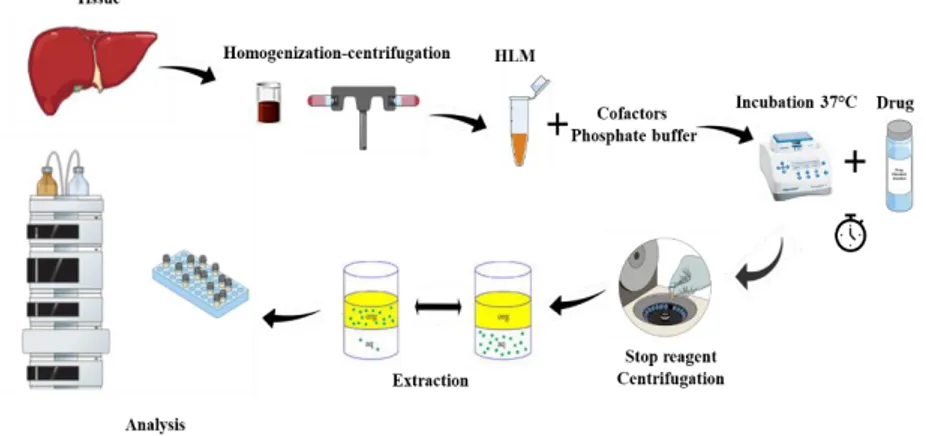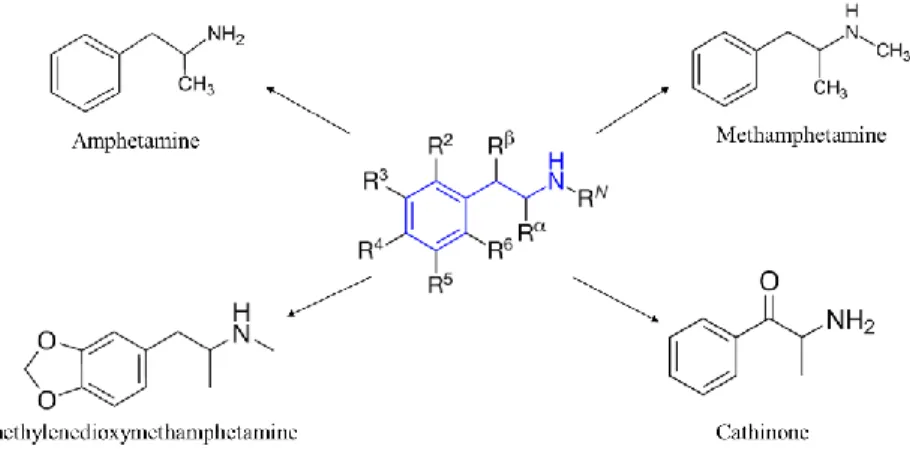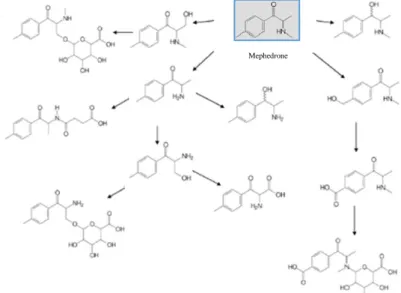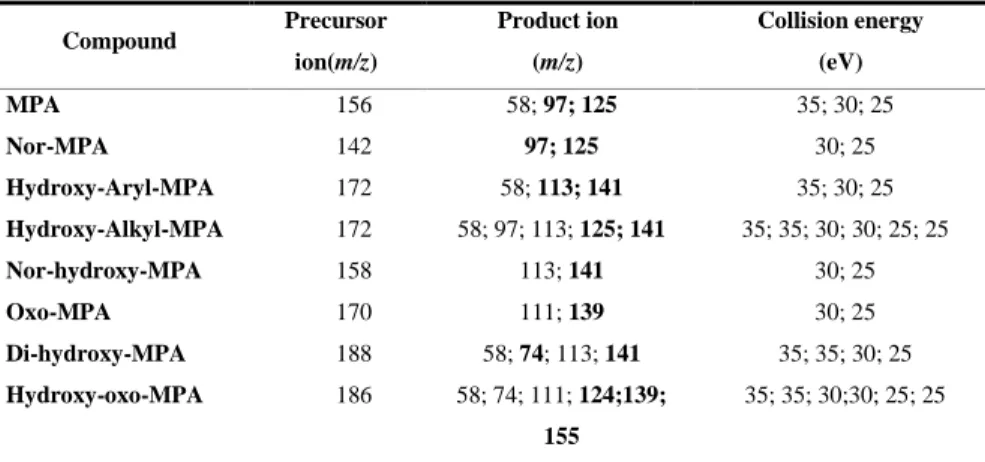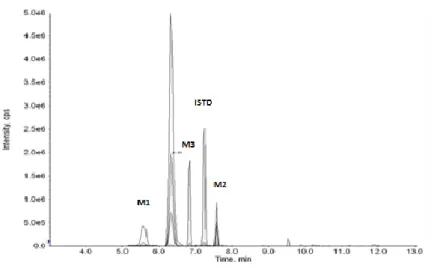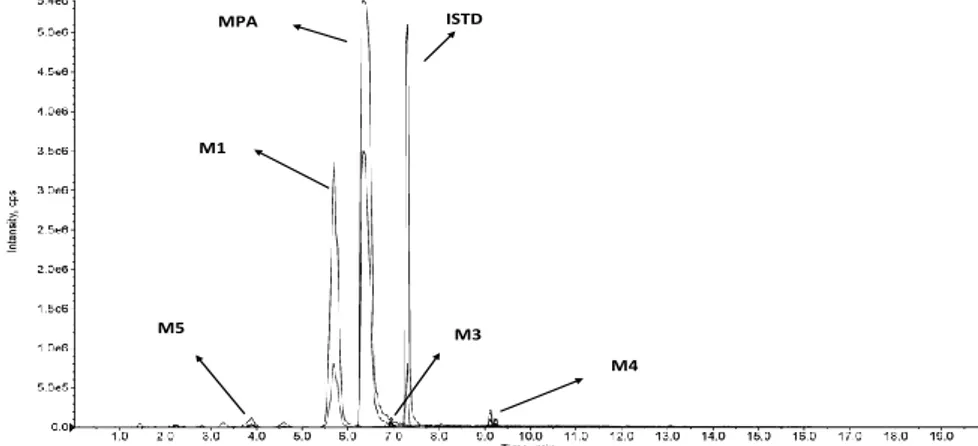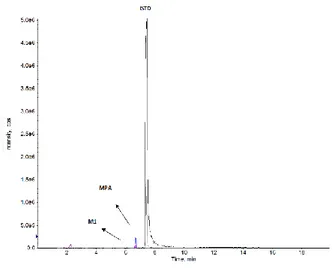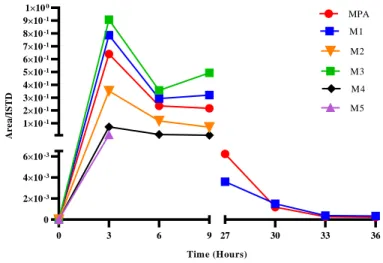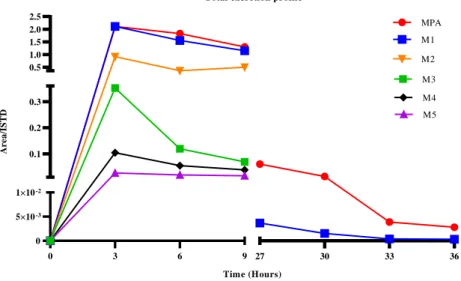1
Characterization of the metabolic
profile of novel psychoactive
substances by a combination of
in vitro and in vivo studies and
chromatographic-spectrometric
techniques
PhD Program in Chemistry
XXXII Cycle (2016-2019)
Cristian Camuto Promotor Co-promotorsProf.Chiara Cavaliere Prof. Francesco Botrè
Ph.D. Supervisor
Prof. Osvaldo Lanzalunga
3
Index
Outline of the study ... 12
Part I
Chapter I
General Introduction ... 15
1 General introduction... 17
1.1 The World Anti-Doping Agency (WADA) ... 17
1.2 New challenge of antidoping analysis and NPS ... 20
2 NPS ... 21
2.1 NPS classification ... 24
2.2 NPS in doping ... 25
-Stimulants ... 25
- Narcotics ... 29
-Cannabinoids ... 31
- Not prohibited psychoactive substances ... 34
Reference ... 36
Part I
Chapter II Background ... 45
1 Drugs: metabolism, excretion and action ... 47
-Phase I reactions... 48
-Phase II reactions... 49
1.1. Drug Excretion and biological matrices ... 50
1.2 Models for metabolism studies ... 52
-Human liver microsomes ... 52
-Murine model ... 54
1.3 Psychostimulants ... 56
4
-Stimulant metabolism and detectability ... 59
1.4 Narcotics ... 61
- GABA analogues ... 61
-Mechanism of action ... 62
-Narcotics metabolism and detectability ... 63
1.5 Synthetic Cannabinoids ... 66
-Mechanism of action ... 67
-Synthetic cannabinoids metabolism and detectability ... 67
Reference ... 70
Part II
Chapter III ... 84
Evaluation of the in vitro and in vivo metabolic profile of
Methiopropamine ... 84
Abstract ... 86
1 Introduction ... 87
2 Experimental ... 89
2.1 Ch emicals ... 89
2.2 Animals and dose ... 90
2.3 Protocol for the in vitro studies ... 90
2.4 Protocol for the in vivo studies... 91
-Sample collection ... 91
-Samples pre-treatment... 91
2.5 Instrumental conditions ... 92
2.6 Method Validation ... 93
-Selectivity ... 93
-LOD ... 93
5
-Recovery ... 93
-Repeatability ... 94
3 Results and discussion ... 95
3.1 Instrumental conditions ... 95
3.2 In vitro studies and optimisation of the sample preparation
protocol ... 96
3.3 In vivo studies after acute administration ... 97
-Phase I and phase II excretion profiles ... 99
3.4 Validation ... 106
-LOD ... 106
-Selectivity ... 107
-Recovery ... 107
-Repeatability ... 108
4 Conclusion... 110
Acknowledgments ... 110
Part II
Chapter IV ... 118
Evaluation of the in vitro and in vivo metabolic profile of 4,4’
DMAR ... 118
Abstract ... 120
1 Introduction ... 121
2 Experimental ... 123
2.1 Chemicals and reagents... 123
2.2 Animals and dose selection ... 124
2.3 In vitro protocol ... 124
6
-In vitro studies ... 125
- In vivo studies ... 126
2.5 Instrumental conditions ... 126
2.5.1 UHPLC-QTOF ... 127
2.5.2 LC-QqQ ... 127
3 Results and discussion ... 129
3.1 Mass spectrometric conditions ... 129
3.1.1 UHPLC-QTOF ... 129
3.1.2 LC-QqQ ... 130
3.2 In vitro metabolism ... 131
-HLM ... 132
-CYP isoforms ... 135
3.3 In vivo studies after acute administration ... 137
-Phase I ... 137
-Phase II ... 138
4 Conclusion... 142
Acknowledgments ... 142
Reference ... 144
Part II
Chapter V ... 147
Evaluation of in vitro metabolism of two cathinones:
Pyrovalerone and Methedrone ... 147
Abstract ... 149
Introduction ... 150
2 Experimental ... 152
7
2.2 In vitro protocol ... 152
2.3 Sample pre-treatment... 153
2.4 Instrumental conditions ... 154
3 Results and discussion ... 155
3.1 Instrumental conditions ... 155
3.2 In vitro metabolism ... 157
-Pyrovalerone ... 158
-Methedrone ... 161
4. Conclusion... 164
Reference ... 166
Part II
Chapter VI ... 170
Excretion profile of Gamma-valero-lactone and affection of
testosterone and IGF-1 level in mice. ... 170
Abstract ... 172
1 Introduction ... 173
2 Experimental ... 175
2.1 Chemical and reagents ... 175
2.2. Animals, dose selection and samples collection ... 176
-In vivo studies ... 176
-Steroid profile ... 176
-IGF-1 immunoassay ... 177
2.3 Excretion studies ... 177
2.3.1 Protocol for the in vitro studies ... 177
2.3.2 Protocol for the in vivo studies ... 178
8
-Phase I-II metabolism ... 178
2.3.3 Instrumental conditions ... 179
2.3.4 Method Validation ... 181
-Selectivity ... 181
-LOD ... 181
-Recovery ... 181
-Repeatability ... 182
2.4 Steroid profile ... 183
-Sample pre-treatment ... 183
-Instrumental conditions ... 184
2.5 IGF-1 immunoassay ... 185
3 Results ... 186
3.1 GVL metabolism study ... 186
-In vitro metabolism study ... 186
-In vivo metabolism study ... 187
3.1.1 Validation results ... 191
- LOD ... 191
- Selectivity ... 191
- Recovery ... 192
- Repeatability ... 192
3.2 Steroid profile ... 194
3.3 IGF-1 immunoassay ... 198
4 Conclusion... 200
Acknowledgments ... 200
9
References ... 202
Part II
Chapter VII ... 209
Evaluation of in vitro metabolism of two new synthetic
cannabinoids ADB-CHMICA and CUMYL-THPINACA ... 209
Abstract ... 211
1. Introduction ... 212
2 Experimental ... 216
2.1 Chemicals and reagents... 216
2.2 In vitro protocol ... 216
2.3 Sample pre-treatment... 217
2.4 Instrumental conditions ... 218
2.4.1 UHPLC-QTOF ... 218
2.4.2 LC-QqQ ... 219
3 Results and discussion ... 220
3.1 Mass spectrometric conditions ... 220
3.1.1 QTOF ... 220
3.1.2 LC-QqQ ... 222
3.2 In vitro metabolism ... 225
-ADB-CHMICA ... 225
-CUMYL-THPINACA ... 229
4 Conclusion... 233
Reference ... 235
12
Outline of the study
This PhD work is focused on those Novel Psychoactive Substances (NPS) which could exert effects as doping agent in sport competitions. Analysis were carried out at “Laboratorio Antidoping FMSI” of Rome part of laboratories around the world accredited by WADA to conduct human doping control sample analyses.
Different substances were selected thorough the years of study, among those NPS with structures and action similar to other compounds already prohibited in sport competitions. The substances of interest were selected according to University of Ferrara department of morphology, surgery and experimental medicine, section of legal medicine, a collaborative centre of Italian Early Warning System (IEWS) and University Cattolica of Rome. This collaboration led to the establishment of a multicentric collaborative group for the IEWS. The aim was to introduce these selected NPS as recognized doping agents searched by laboratories routine drug test of World Antidoping Agency (WADA), or forensic toxicology laboratories. With this aim specific compounds were selected and their potential effects were evaluated through in vivo behavioural studies employing murine model as a model of human behaviour and metabolism. The substances were administered to mice groups and behavioral studies were carried out at University of Ferrara to establish potential stimulant effects, which configure substances as stimulant compound in-competition. When a substance has showed typical effects as a doping agent, metabolism studies were carried out by our laboratory employing human liver microsomes or CYPs isoform as a model of human oxidative metabolism, and samples were analysed through liquid chromatography mass spectrometry techniques.
The selected substances are: Methiopropamine, 4,4’ Dimethylaminorex, Pyrovalerone, Methedrone, γ-valerolactone, ADB-CHMICA, CUMYL-THPINACA.
13
All of these substances show potential stimulant effects known in literature or proved by behavioral studies provided by University of Ferrara. They were selected in accordance with IEWS alert on their abuse in Italy and their potential implication with fatal intoxication. For selected substances (Methiopropamine, GVL, 4,4’ DMAR) tissue damage were also estimated by collaboration with University Cattolica of Rome.
For all the substances in vitro metabolism studies were carried out to in order to investigate metabolic pathways reactions and select the most suitable markers of intake.
Methiopropamine, 4,4’-dimethylaminorex, and γ-valerolactone are substances of interest in forensic analysis as potential hazardous novel abused recreational drugs with unknown metabolism and /or excretion. The in vivo metabolism of these compounds was therefore studied employing mice as metabolism model. The matrix selected was urine as the elected matrix for doping and toxicological analysis. Collected data from the three unit were linked and proposed to IEWS with the aim to bring up the unknowledge on these substances and to propose the introduction of fundamental data on their toxicology, effects and metabolism on EWS international database.
15
Part I
Chapter I
17
1 General introduction
1.1 The World Anti-Doping Agency (WADA)
The origin of the word “doping” is still unclear but appeared for the first time in an English dictionary in 1889, where the word was used to describe a remedy containing opium commonly used to increase racehorse’s performances 1. Doping
could be defined as the attempt to enhance the athlete’s performances in sport by illegal administration of pharmaceuticals or application of prohibited methods 2.
Today, violation of doping rules were described in the World Anti-Doping Code (WADC), where “doping” is defined as the occurrence of one or more of the anti-doping rules violations described from the article 2.1 to the article 2.8 of the Code, that are: “(i) presence of a prohibited substance or its metabolites or markers in an athlete sample; (ii) the use or attempted use by athlete of a prohibited substance or a prohibited method; (iii) refusing or falling without compelling justification to submit to sample collection after notification as authorized in applicable anti-doping rules, or otherwise evading sample collection; (iv) violation of applicable requirements regarding athlete availability of out-of-competition testing, including failure to file required whereabouts information and missed tests which are declared based on rules which comply with the international standard for testing; (v) tampering or attempting to tamper, with any part of doping control; (vi) possession of prohibited substances and prohibited methods; (vii) trafficking or attempted trafficking in any prohibited substance or prohibited method, and (viii) administration or attempted administration to any athlete of any prohibited method or prohibited substance”3.
18
In 1998, one of the biggest scandals in the history of sports led to the creation of the World Anti-Doping Agency (WADA). Right before the beginning of 1998 Tour de France, a large number of prohibited substances were found by French Custom police inside the car of the long-time masseur for the former Festina road-racing team, Willy Voet and several top teams and athletes were also implicated in this kind of illicit tasks 4–6.
Subsequently a World Conference on Doping was held in February 1999 in Lausanne. The need for an independent international agency for doping became clear, which led to the establishment of the WADA on November of the same year. Its main mission was to coordinate and promote the development of international standardized antidoping rules, facilitate the coordination between sport organization and governmental authorities, ongoing with doping control research, and promote doping prevention activities 7,8.
In 2003, WADA adopted the World Anti-Doping Code (WADC) that became the first worldwide accepted document providing a set of harmonized antidoping policies, rules and regulations within sport organizations and public authorities. The current version of WADA Code3 is under review with the aim to improve several
aspects of anti-doping rules (2021 code review process).
Nowadays, the WADA Programme is articulated in three levels that are: • The WADA Code 3
• The International Standards 9 (Prohibited List, Testing and Investigation
Laboratories, Therapeutic Use Exemption, Protection on Privacy and Personal Information)
19
Following the adoption of the first WADA Code in 2003, WADA, at least once a year, updates the Prohibited List of Substances and Methods in sport.
The current version of the prohibited List is reported below 10
Table 1. The Prohibited List 2019, class of substances of interest in this PhD thesis are in bold.
PROHIBITED SUBSTANCES Prohibited in- and out-of-competition S0. Non-approved substances S1. Anabolic agents
S2. Peptide hormone, growth factors, related substances and mimetics S4. Hormone and metabolic modulators
S5. Diuretics and masking agents
Prohibited substance in-competition S6. Stimulants
S7. Narcotics S8. Cannabinoids
S9. Glucocorticoids PROHIBITED METHODS
M1. Manipulation of blood and blood components M2. Chemical and physical manipulation
M3. Gene and cell doping
SUBSTANCE PROHIBITED IN PARTICULAR SPORTS P1. Beta-blockers
20
1.2 New challenge of antidoping analysis and NPS
In the last fifteen years, from the introduction of the WADA code to date, there were very important milestones in the fight against doping. In 2004 at Summer Olympic Games, a reliable test for hGH was introduced 11, in 2008 it was developed the first
method for determination of insulins 12, in 2009 it was introduced the Athlete
Biological Passport (ABP) 13 in 2011 the Section S0 of “ Non-Approved Substances”
was inserted in the WADA Prohibited List, in 2014 and 2015 respectively the gas Xenon and the stabilizes of Hypoxia-inducible factors (HIF) were inserted in the Prohibited List and in Summer Olympic Game of Rio de Janeiro in 2016 the first test for Gene Doping was done14.
Nowadays anti-doping community faces new challenges with NPS which are the same encountered by forensic and toxicology laboratories. These substances are constantly developing with new compound or classes introduced, with almost unknown structures, effects or metabolism for each compound which configure as an emerging global problem 15. The identification of prohibited substances through
spectrometric techniques requires the previous knowledge of the chemical structure of the substance and its mass spectrum, none of which are known for the NPS recently introduced in the market.
NPS could be detected into different biological matrices as not only drug itself but also as phase I and phase II metabolites. NPS are mainly analysed through MS techniques 16, which is a preferred method of analysis in doping control, or forensic
analysis, due to its versatility and the possibility to establish the nature and structure of the detected substance. However, NPS could be detected with different spectroscopy techniques like Raman, IR or NMR17–21. These techniques are helpful
for those new compounds where the structures are unknown and a characterization is required with information more detailed than MS spectra fragmentation,
21
becoming a support to MS techniques for the unique identification of the substances structures 17. Strategies of NPS analysis are based on the characterization of their
chemical structures and effects22, on how NPS could be metabolized into human and
how are could be found in biological matrices23–26. An important tool for the
identification of NPS in biological matrices came from in vivo studies 16,27. However,
the metabolism of NPS is unknown and cannot be established by doing excretion studies in humans, since NPS are not approved drugs, and human metabolism could only come from intoxication cases (e.g. emergency room)28,29. Therefore, the use of
in vitro model and in vivo studies through animal model (e.g. mouse) is mandatory for a metabolism study as close as possible to human 24,30. Here a background on
NPS classification and impact in doping is provided.
2 NPS
“According to the United Nations, new psychoactive substances are defined as substances of abuse, either in a pure form or a preparation, that are not controlled by the 1961 Single Convention on Narcotic Drugs or the 1971 Convention on Psychotropic Substances, but which may pose a public health threat”.
The term “new” does not necessarily refer to new compounds as several NPS were first synthesized more than 40 years ago, but to substances that have recently become available on the market 15.Joint Action on New Synthetic Drugs were established by
Joint Action 97/396/JHA and that had been in operation since 1997,and it was strengthened in 2005 by Council Decision 2005/387/JHA. As of 23 November 2018, it operates under Regulation (EC) 1920/2006 (as amended by Regulation (EU) 2017/2101). It provides a network for the reporting of new substances called Early Warning System (EWS), which provide a risk assessment on NPS 31, an annual
report on commonly abuse drug and NPS recently introduced in Europe and relative risk assessment 32,33.
22
The EWS is composed of a multiagency and multidisciplinary network, which includes the European Monitoring Centre for Drugs and Drug Addiction (EMCDDA), 30 national early warning systems (28 EU Member States, Turkey, and Norway), Europol and its law enforcement networks, the European Medicines Agency (EMA), the European Commission, and other partners.
The EMCDDA, in cooperation with Europol, is responsible for linking and communicate the information reported by the network in order to provide initial report on an NPS that may pose health or social risks at EU. That annual draw up a report on commonly abuse drug and NPS recently introduced in Europe and relative risk assessment. By the end of 2018, the EMCDDA was monitoring more than 730 NPS, 55 of which were detected for the first time in Europe in 2018 (Fig. I.1) 32,33.
Regulating organization for NPS include not only EMCDDA, also United Nations Office on Drugs and Crime (UNODC), WADA, World Health Organization (WHO), Food and Drug Administration (FDA) 34–36 . At global level the UNODC established
in 2013 a system for collecting information on NPS, similar to the EWS, called UNODC/NPS Early Warning Advisory, part of The Global SMART (Synthetics Monitoring: Analyses, Reporting and Trends) Programme “ to monitor the emergence of NPS, analyse the market trends associated with NPS, provide information on legal instruments countries have used to control these substances, further support drug testing laboratories with analytical methodologies to identify NPS and support the formulation of effective measures to mitigate this problem at the international level”.43
23
In Italy, these drugs are included in four specific tables of decree DPR 309/90, see figure 2.
Figure I.2. Classification of illicit substances into DPR 309/90 in Italy.
Figure I.1. Number and categories of new psychoactive substances notified
24
2.1 NPS classification
NPS represent a large family of substances which include different classes such as synthetic cannabinoids , synthetic cathinone, piperazines, benzofurans, synthetic opioids, synthetic amphetamines etc 36–38. These substances can be classified both
for their structure or their activity. A unique classification of NPS is complex, however, according to Zawilska and Wojcieszak six classes of principal NPS can be defined, based on their pharmacological activity 39.
They are:
Table I.2. Class of NPS where compound of interest in this PhD thesis are in bold. Class of NPS Psychostimulants Narcotics /hypnotics Synthetic cannabinoids Psychedelic compounds Dissociatives compounds Synthetic opioids
The structures and mechanism of action for those class of substances that are mainly linked with this PhD thesis are described in Chapter II of Part I.
25
2.2 NPS in doping
Psychoactive substances (PS) are one of the most commonly abused substances into sport competition 40, and they have a prominent place into the Prohibited List since
2004 41. In recent years the constant growth of NPS phenomena especially affect
young athletes that represent the predominant group in sports42,43. Nowadays, NPS
can be easily purchased through the Internet and in many cases could be found in dietary supplements, without properly indication of their presence on the packaging. Therefore, the risk of inadvertent doping with supplements is very high for athletes who usually employed dietary supplements. 41,43.
All PS and NPS substances are prohibited only in competition due to their short activity which increases sports performance during the competition.
Principal categories of PS prohibited in sports include also NPS and could be dived into Stimulant, Narcotics and Cannabinoids. These classes of substances are the core of this PhD thesis. Methiopropamine, Methedrone, Pyrovalerone and 4,4 DMAR are classifiable as stimulants, GVL as ascribable to narcotics and it shows also proactive effects at low dosages. Whereas CUMYL-THPINACA, ADB-CHMICA are classified as synthetic cannabinoids and they different effects including stimulant and narcotic effects useful for doping purpose.
-Stimulants
The US Anti-Doping Agency defines a stimulant as “An agent, especially a chemical agent such as caffeine, that temporarily arouses or accelerates physiological or organic activity”44.
All substances with stimulant effects that could be improve sports performance are prohibited and collocated in S6 section of WADA prohibited list (Figure 3A-B), except for those included in the Monitoring Program45.
26
To the date of writing, the substances included in the Monitoring Program as potential stimulants are bupropion, caffeine, nicotine, phenylephrine, phenylpropanolamine, pipradrol and synephrine.
27
Figure I.3B. S6 section of WADA prohibited list 2019 10.
Stimulants mainly include amphetamine and cathinone derivatives as well as approved drugs (e.g. ethylphenidate, modafinil, phentermine, pseudoephedrine). NPS stimulants are derivatives of phenethylamine or cathinone easily available on internet or included in dietary supplements.
Stimulants were manufactured usually as tablets or powder (e.g for synthetic cathinone sell as “bath salt”) with characteristic logos (Figure 4), not necessary illegal at the first time they appeared and sold.
28
They were often marketed through criminal networks as ‘Ecstasy’, a term which initially meant MDMA or one of its homologues31.
Figure I.4. Stimulant sold as club drugs or party drugs, (photo free available on-line)*1
Stimulants are divided into the Prohibited List in “specified” and “non-specified” since 2009. This classification is based on different criteria including “risk to health, general use as medications, legitimate market availability, controlled status and historical abuse in sports” 41 .
Specified stimulants are generally drugs that are more susceptible to accidental intake because they also include medical drugs or are sold as supplements where different NPS are added and not named or not properly indicated on the labels. This division is linked to the severity of sanctions and the period of ineligibility for the athlete (2 years for specified or 4 years for non-specified).1
*1 https://storage.googleapis.com/stateless-bhekisisa-website/wordpress-uploads/2019/03/7ce8daa1-00-psychedelic-therapy-mdma-and-mental-health-disorders.jpeg
29
As WADA established “the Prohibited List may identify specified substances, which are particularly susceptible to unintentional anti-doping rule violations because of their general availability in medicinal products or are less likely to be successfully abused as doping agents…Athlete can establish that the use of such a specified substance was not intended to enhance sport performance”46. Therefore, athlete’s
sanction could be reduced.
The Section S6 of the WADA prohibited List is an open list that mean only exemplificative substances are direct included into the list. Substances with similar chemical structures and biological effects will be prohibited despite not explicitly indicated in the list. The open list concept is useful for those substances like NPS where newly substances with similar structure are frequently introduced into the market.
When a class became consistent, it is included by name in the Prohibited List (e.g. cathinone and analogues 2014, phenethylamines and analogues 2015)41.
Methiopropamine and 4,4’ DMAR are referable to phenethylamines class, whereas Pyrovalerone and Methedrone are part of cathinone and analogues.
- Narcotics
Narcotics are included in the section S7 of the WADA Prohibited list which is a closed list, mean only drugs included by name are prohibited, except for fentanyl derivatives (Figure 5). Fentanyl derivatives are also ones of the first designer drugs synthesised and sold on illicit drug market (e.g. α-methylfentanyl and 3-methylfentanyl)31. Therefore, an abused NPS which is recognizable as abused in
sports needs to be introduced by name in the list after it was included in the WADA Monitoring Program to follow the real abuse of it among athletes. At the date of writing codeine, hydrocodone and tramadol are included into monitoring programme as suitable substances prohibited in-competition45.
30
Figure I.5. S7 section of WADA prohibited list 2019 10.
Few new substances have been introduced in the list of Narcotics (e.g. nicomorphine in 2017)41. However, the recent trend on GABA analogue substances, especially
GHB 47, could be of impact in doping control and will be lead to the introduction of
GHB and analogues into WADA Narcotics section (e.g. 1,4 butanediole or GBL48,
as well as GVL investigated into this PhD thesis). Originally, GHB was reported to be employed by competitive body builders in the 1980s for its effects in acutely facilitating slow-wave sleep, and increase on growth hormone level 31, action
confirmed in different studies as well as seen for other GABA analogues 49–52. These
substances show also proactive behaviour, sexual desire53,54 and, more important,
31
Around the 1980s/early 1990s GHB was listed in Schedule IV of the United Nations Convention on Psychotropic Substances. Due to its effects GHB is sold also as “liquid ecstasy”
-Cannabinoids
Cannabinoids are introduced in prohibited list at the section S8. Where they are named as natural cannabinoids from Cannabis sativa and their products (e.g. hashish, marijuana) and synthetic cannabinoids (SCs) with cannabimimetics action (Figure 6).
ac
Figure I.6. S8 section of WADA prohibited list 2019 10.
S8 section is an open list that mean all substances which show cannabimimetics effects are intended as prohibited in-competition by WADA.
Currently WADA will commission a target study to perform metabolism studies and to develop properly detection method if a SC consume became preponderant 41 in
32
Natural Cannabinoids were introduced in Prohibited List in 2004, followed by the introduction of first synthetic cannabinoids in 2010 because of the growing prevalence of Spice and K2 41, first identified in smoking mixtures around 2008 31.
These are the commercial name for mixtures of JWH018, JWH073 or HU-210. Soon after their introduction into the market they have been abused by young athletes
56, in particular JWH018 and JWH073 were commonly found in urine specimen of
athletes, Heltsley et.al. (2012)42 found that 4.5% of urine samples collected from
5.956 athletes, analysed by high-performance liquid chromatography–tandem mass spectrometry, are positive to JWH018 and JWH073 metabolites.
SCs are sold generally as smokable powder or for oral intake with various logos and without their proper name (Figure 7), labelled as: “non for human consumption, lab tested or verified the absence of prohibited substances”. Declaration of “not approval by FDA” is also common reported.
Figure I.7. Different packaging for synthetic cannabinoids, (adapted from different photo free available
on-line)*2
*2
https://www.health.ny.gov/professionals/narcotic/synthetic_cannabinoids/images/synthetic_cannabinoids_600x338.jpg%2F%2Fwww.h ealth.ny.gov
33
Nowadays SCs are one of the most diffused and abused class of NPS. with a high potential and often unknown risks associated with their consumption 57.
Furthermore, SCs are divided into various subclasses with different structures which significantly complicated their detectability through common forensic toxicological screening. In addition, as for other NPS, reference materials for parent drug aren’t available for at least 6-24 months after new substances were discovered 31, and also
producer of these materials facing new challenge to speed up production processes
58. Forensic analysis and doping control where cannabinoids are included, use urine
as matrix and the metabolism of these illegal NPS was unknown.
Therefore, in vitro metabolic investigations, became mandatory to the identification and characterization of metabolites 59 and also to their enzymatic synthesis41
34
- Not prohibited psychoactive substances
Not all the psychoactive substances are included in the WADA Prohibited List. Indeed, a psychoactive substance (include NPS) must have specific action that allows is consumption for doping purpose. In particular a substance or method must meet at least two of the following criteria: (1) enhances the performance and poses a health risk, (2) enhances the performance and violates the spirit of sport, or (3) poses a health risk and violates the spirit of sport 60. This means that some classic
hallucinogens (e.g. LSD, psilocybin) and sedatives/hypnotics (e.g. benzodiazepines barbiturates) are not prohibited in sports due to their action as sedatives and depressants of locomotory activity, mean they match with only the third criteria. As the author of this thesis consideration, this is probably why substances like GHB are not included in WADA list because of its most known activity as a rape and depressant drug compared to its underestimated enhance activity effects at low dosage. Furthermore GHB was found in seizure in 2004 by Guardia Civil in Spain with different stimulants, anabolic and masking agents suggesting its possible employ as a doping agent 61.
36
Reference
1. Schwanstecher, M. Handbook of Experimental Pharmacology: Preface. Handbook of Experimental Pharmacology (2011). doi:10.1007/978-3-642-17214-4
2. Catlin, D. H., Fitch, K. D. & Ljungqvist, A. Medicine and science in the fight against doping in sport. Journal of Internal Medicine (2008). doi:10.1111/j.1365-2796.2008.01993.x
3. Agency, W. A. D. World Anti-Doping Code. World Anti-Doping (2015). doi:10.1016/S0140-6736(12)60080-4
4. Engine, H. Brief History of. Med. Sport Sci. (2003). doi:10.1159/000460680
5. Jelkmann, W. & Lundby, C. Blood doping and its detection. Blood (2011). doi:10.1182/blood-2011-02-303271
6. Robinson, N. et al. Erythropoietin and blood doping. British Journal of Sports Medicine (2006). doi:10.1136/bjsm.2006.027532
7. Kamber, M. Development of the role of National Anti-Doping
Organisations in the fight against doping: From past to future. Forensic Sci. Int. (2011). doi:10.1016/j.forsciint.2011.07.026
8. Kamber, M. & Mullis, P. E. The Worldwide Fight Against Doping: From the Beginning to the World Anti-Doping Agency. Endocrinology and Metabolism Clinics of North America (2010).
doi:10.1016/j.ecl.2009.10.009
9. World Anti-Doping Agency. International Standard for Laboratories (ISL). 1–97 (2019)
37
10. World Anti-Doping Agency. What is Prohibited. World Anti-Doping Agency (2019).
11. Saugy, M. et al. Human growth hormone doping in sport. British Journal of Sports Medicine (2006). doi:10.1136/bjsm.2006.027573
12. Thevis, M., Thomas, A. & Schänzer, W. Mass spectrometric determination of insulins and their degradation products in sports drug testing. Mass Spectrom. Rev. (2008). doi:10.1002/mas.20154
13. Sottas, P. E., Robinson, N., Rabin, O. & Saugy, M. The athlete biological passport. Clinical Chemistry (2011). doi:10.1373/clinchem.2011.162271 14. Thevis, M., Kuuranne, T. & Geyer, H. Annual banned-substance review:
Analytical approaches in human sports drug testing. Drug Test. Anal. (2019). doi:10.1002/dta.2549
15. Tettey, J. N. & Levissianos, S. The global emergence of NPS: An analysis of a new drug trend. in Novel Psychoactive Substances: Policy, Economics and Drug Regulation (2017). doi:10.1007/978-3-319-60600-2_1
16. Peters, F. T. & Meyer, M. R. Analytical Techniques for the Detection of Novel Psychoactive Substances and Their Metabolites. in Novel Psychoactive Substances: Classification, Pharmacology and Toxicology (2013). doi:10.1016/B978-0-12-415816-0.00006-7
17. Assi, S., Osselton, D. & Wallis, B. The evaluation of dual laser handheld raman spectroscopy for identifying novel psychoactive substances. Am. Pharm. Rev. (2016).
18. Assi, S., Guirguis, A., Halsey, S., Fergus, S. & Stair, J. L. Analysis of ‘legal high’ substances and common adulterants using handheld
38
19. Lobo Vicente, J. et al. Systematic analytical characterization of new psychoactive substances: A case study. Forensic Sci. Int. (2016). doi:10.1016/j.forsciint.2016.01.024
20. Dobaja, M., Grenc, D., Kozelj, G. & Brvar, M. Occupational transdermal poisoning with synthetic cannabinoid cumyl-PINACA. Clin. Toxicol. (2017). doi:10.1080/15563650.2016.1278224
21. Gambaro, V. et al. Identification and characterization of a new designer drug thiothinone in seized products. Forensic Toxicol. (2016).
doi:10.1007/s11419-015-0289-2
22. Institóris, L. et al. Frequency and structure of stimulant designer drug consumption among suspected drug users in Budapest and South-East Hungary in 2012-2013. Forensic Sci. Int. (2015).
doi:10.1016/j.forsciint.2015.01.002
23. Chung, H., Lee, J. & Kim, E. Trends of novel psychoactive substances (NPSs) and their fatal cases. Forensic Toxicol. (2016).
doi:10.1007/s11419-015-0286-5
24. Staack, R. & Maurer, H. Metabolism of Designer Drugs of Abuse. Curr. Drug Metab. (2005). doi:10.2174/1389200054021825
25. Kintz, P., Villain, M. & Cirimele, V. Hair analysis for drug detection. Therapeutic Drug Monitoring (2006).
doi:10.1097/01.ftd.0000211811.27558.b5
26. Verstraete, A. G. Detection Times of Drugs of Abuse in Blood, Urine, and Oral Fluid. in Therapeutic Drug Monitoring (2004).
39
27. Asha, S. & Vidyavathi, M. Role of human liver microsomes in in vitro metabolism of drugs-A review. Applied Biochemistry and Biotechnology (2010). doi:10.1007/s12010-009-8689-6
28. Andresen-Streichert, H., Jungen, H., Gehl, A., Müller, A. & Iwersen-Bergmann, S. Uptake of valerolactone-detection of gamma-hydroxyvaleric acid in human urine samples. J. Anal. Toxicol. 37, 250–254 (2013).
29. Pozo, Ó. J. et al. Mass spectrometric evaluation of mephedrone in vivo human metabolism: Identification of phase i and phase II metabolites, including a novel succinyl conjugate. Drug Metab. Dispos. (2015). doi:10.1124/dmd.114.061416
30. Tyrkkö, E., Pelander, A., Ketola, R. A. & Ojanperä, I. In silico and in vitro metabolism studies support identification of designer drugs in human urine by liquid chromatography/quadrupole-time-of-flight mass spectrometry. Anal. Bioanal. Chem. (2013). doi:10.1007/s00216-013-7137-1
31. King, L. A. & Kicman, A. T. A brief history of ‘new psychoactive substances’. Drug Test. Anal. 3, 401–403 (2011).
32. EMCDDA. European Drug Report Trends and Developments. Eur. Drug Rep. (2019).
33. EMCDDA. Risk assessment of new psychoactive substances Operating guidelines. European Monitoring Centre for Drugs and Drug Addiction Risk (2010). doi:10.2810/2428
34. Hanstad, D. V., Smith, A. & Waddington, I. The Establishment of the world anti-doping agency: A study of the management of organizational change and unplanned outcomes. Int. Rev. Sociol. Sport (2008).
40
35. Mackey, T. K. & Liang, B. A. Improving global health governance to combat counterfeit medicines: A proposal for a UNODC-WHO-Interpol trilateral mechanism. BMC Med. (2013). doi:10.1186/1741-7015-11-233 36. Papaseit, E., Farré, M., Schifano, F. & Torrens, M. Emerging drugs in
Europe. Current Opinion in Psychiatry (2014). doi:10.1097/YCO.0000000000000071
37. Schifano, F., Orsolini, L., Papanti, D. & Corkery, J. NPS: Medical
consequences associated with their intake. in Current Topics in Behavioral Neurosciences (2017). doi:10.1007/7854_2016_15
38. European Monitoring Centre for Drugs and Drug Addiction (EMCDDA). New psychoactive substances in Europe. An update from the EU Early Warning System. EU early Warning System (2015). doi:10.2810/372415 39. Zawilska, J. B. & Wojcieszak, J. Synthetic Cathinones. 12, (Springer
International Publishing, 2018).
40. Strano Rossi, S. & Botrè, F. Prevalence of illicit drug use among the Italian athlete population with special attention on drugs of abuse: A 10-year review. J. Sports Sci. 29, 471–476 (2011).
41. Mazzoni, I., Barroso, O. & Rabin, O. Anti-doping challenges with novel psychoactive substances in sport. in Novel Psychoactive Substances: Policy, Economics and Drug Regulation (2017). doi:10.1007/978-3-319-60600-2_4
42. Heltsley, R. et al. Prevalence of synthetic cannabinoids in U.S. Athletes: Initial findings. J. Anal. Toxicol. (2012). doi:10.1093/jat/bks066
41
43. Corazza, O. & Roman-Urrestarazu, A. Editorial introduction: The proliferation of NPS as a ‘game changer’ for public health policy. Nov. Psychoact. Subst. Policy, Econ. Drug Regul. xiii–xviii (2017).
doi:10.1007/978-3-319-60600-2
44. USADA. US Anti-Doping Agency (2007) www.usantidoping.org>. 45. World Anti-Doping Agency (2019) Monitoring program.
https://www.wada-ama.org/en/resources/science-medicine/monitoring-program.
46. WADA (World Anti-Doping Agency) (2007) www.wada-ama.org>. 47. Alempijević, D., Savić, S., Stojanović, J. & Spasić, A. Drug facilitated
sexual assault. Srpski arhiv za celokupno lekarstvo (2007). 48. Corkery, J. M. et al. Gamma hydroxybutyrate (GHB), gamma
butyrolactone (GBL) and 1,4-butanediol (1,4-BD; BDO): A literature review with a focus on UK fatalities related to non-medical use. Neurosci. Biobehav. Rev. 53, 52–78 (2015).
49. Jones, L. M. & Legge, M. Fasting growth hormone levels may be elevated by chronic Baclofen administration in physically active spinal cord injured men. New Zeal. J. Sport. Med. 35, 54–58 (2008).
50. Bauman, W. A., La Fountaine, M. F., Cirnigliaro, C. M., Kirshblum, S. C. & Spungen, A. M. Low-dose baclofen therapy raised plasma insulin-like growth factor-1 concentrations, but not into the normal range in a
predictable and sustained manner in men with chronic spinal cord injury. J. Spinal Cord Med. 36, 476–482 (2013).
51. Brailsford, A. D., Bartlett, C., Kicman, A. T. & Cowan, D. A. Increases in serum growth hormone concentrations associated with GHB
42
52. Brailsford, A. D., Cowan, D. A. & Kicman, A. T. Pharmacokinetic properties of γ-hydroxybutyrate (GHB) in whole blood, serum, and Urine. J. Anal. Toxicol. (2012). doi:10.1093/jat/bkr023
53. Kapitány-Fövény, M. et al. Enhancing sexual desire and experience: An investigation of the sexual correlates of gamma-hydroxybutyrate (GHB) use. Hum. Psychopharmacol. (2015). doi:10.1002/hup.2491
54. Bosch, O. G. et al. Gamma-hydroxybutyrate enhances mood and prosocial behavior without affecting plasma oxytocin and testosterone.
Psychoneuroendocrinology 62, 1–10 (2015).
55. Quang, L. S., Phattanarudee, S. & Maher, T. J. Lower-dose GHB produces increased locomotion in mice for the open field test . J. Toxicol. Clin. Toxicol. (2004).
56. Egan, K. L., Erausquin, J. T., Milroy, J. J. & Wyrick, D. L. Synthetic Cannabinoid Use and Descriptive Norms among Collegiate Student-Athletes. J. Psychoactive Drugs (2016).
doi:10.1080/02791072.2016.1186305
57. Martinotti, G. et al. Synthetic Cannabinoids: Psychopharmacology, Clinical Aspects, Psychotic Onset. CNS Neurol. Disord. - Drug Targets (2017). doi:10.2174/1871527316666170413101839
58. Archer, R. P., Treble, R. & Williams, K. Reference materials for new psychoactive substances. Drug Testing and Analysis (2011).
doi:10.1002/dta.317
59. Peters, F. T. & Meyer, M. R. In vitro approaches to studying the
metabolism of new psychoactive compounds. Drug Testing and Analysis (2011). doi:10.1002/dta.295
43
60. Geeraets, V. Ideology, Doping and the Spirit of Sport. Sport. Ethics Philos. (2018). doi:10.1080/17511321.2017.1351483
45
Part I
Chapter II
47
1 Drugs: metabolism, excretion and action
For toxicological and forensic analysis, the understanding of how a substance can be excreted in different biological matrices and how long it will be excreted is mandatory. Metabolism of drugs involves different tissues and organs, liver as the most important organ, but also the kidneys, intestines, lungs, brain, nasal epithelium, and skin can be involved 1. The metabolism of xenobiotics is often divided into two
phases: modification and conjugation, followed by the excretion. These two phases are commonly known as respectively phase I and phase II metabolism. The metabolic pathways of different substances mainly involve oxidative phase I reactions mediated by different cytochromes isoforms (CYPs) which are the major enzymes responsible for drug metabolism, accounting for about 75% of the total metabolism. 2.
CYP450 are a family of enzymes containing as well as for other CYP a heme core (Figure 1) as a cofactor that function as monooxygenases 3,4. directly involved in
metabolism 5, which play a major role in phase I oxidation reactions 6.
Figure II.1. Representation of cytochrome P450 oxidases
48
Indeed, in mammals these proteins oxidize different endogenous substances and xenobiotics, leading to an increase in hydrophilicity of substances that induce their urinary excretion as a common mechanism of body defence 7.
Humans have 57 genes and more than 59 pseudogenes divided among 18 families of cytochrome P450 genes and 43 subfamilies 8.
The most common isoforms of CYPs involved in drug metabolism are CYP3A4, CYP2C8, CYP2C9, CYP2C19, CYP2D6 and CYP2E1, where the first number is the family (1,2,3 etc.), the letter (A, B, C etc.) is the subfamily and the last number is gene identifier (1,2,3 etc .), see Figure 2 for the scheme.
Figure II.2. scheme of nomenclature of different CYP450 into human.
-Phase I reactions
The most common phase I reactions act to incorporate an atom of oxygen into nonactivated hydrocarbons, which could result in either the introduction of hydroxyl groups or N-, O- and S-dealkylation of substrates 9. These reactions include
aryl-hydroxylation, alkyl-aryl-hydroxylation, deamination, O-dealkylation, N-dealkylation, N-oxidation, S-oxidation.
49
-Phase II reactions
Phase II enzymes catalysed reactions of conjugation with charged species such as glutathione, sulphate, glycine, or glucuronic acid. Products of conjugation reactions have an increased molecular weight and tend to be less active than their substrates. The addition of these groups produces more polar metabolites that cannot diffuse across membranes, and may, therefore, be actively transported. These reactions are catalysed by a large group of different transferases, which can metabolise the phase I compounds or hydrophobic compounds which contains nucleophilic or electrophilic groups. The most representative phase II enzymes are uridine 5'-diphospho-glucuronosyltransferase (UGT), glutathione S-transferase (GST), Methyl-transferase (MT), N-acetyl transferase (NAT), and sulfotransferase (ST) 10.
A summary scheme of phase I and phase II reaction is reported below in Figure 3.
50
1.1. Drug Excretion and biological matrices
Drug excretion is the removal of drugs from the body, as metabolite(s), after phase I and phase II metabolism, or the excretion of the unchanged drug (parent). There are different routes of excretion, including urine, bile, sweat, saliva, tears, milk, and stool, where the principal way of excretion is urine. The most important excretory organs are the kidneys and liver. Renal excretion plays an important role in eliminating unchanged drugs or their metabolites into urine, it depends on glomerular filtration, active tubular secretion, and passive tubular absorption. The main characteristics of compounds excreted in urine is that they are polarized and water-soluble.
Lipophilic drugs are not removed by the kidneys and require hepatic metabolism (e.g., phase I and phase II biotransformation reactions) to increase their water solubility for possible urinary excretion. Drugs that entering the hepatic circulation may also enter the bile and be excreted into the duodenum and small intestines. Drugs with a molecular weight over 300 daltons and with lipophilic groups are more likely to be excreted in bile 11.
The unchanged drugs and phase I and phase II metabolites could be found into biological matrices after drug intake. A scheme of principal matrices employed in toxicological analysis is proposed in Figure 4.
51
In forensic toxicology, the most common matrices of excretion are urine and saliva as well as blood and hair that are not considerable as routes of excretion. However, they are both important biological matrices in forensic analysis 12–14. Hair, urine and
saliva are considered non-invasive matrices and they are employed in different toxicological analysis related to drug of abuse discovery 12,15.
Hair are useful for discovery old intake of substances as well as in control of patients with story of drug addiction 16. Saliva is becoming an important tool in fast drug
screening 17. At the data of writing only urine and blood (whole blood plasma and
serum) are employed in doping control, therefore a detailed explanation of the use of other biological matrices in forensic analysis is beyond the scope of this text. Urine is the matrix of choice for the majority of doping control analysis due to the non-invasive sampling and to the possibility to link excretion data with time of intake. Urine is employed for discovery of all synthetic stimulants, cannabinoids and narcotics (field of study of this thesis), where blood is employed only for identification of “hematic doping” (e.g. determination of: Grow Hormone, erythropoietin, blood transfusion etc.). Furthermore, urine shows long storage stability (especially at -80° C) proved for a variety of substances, easy sampling and managing and also sample treatment. The low volume used for anti-doping analysis allow to employ different aliquot of samples for different drug screening or repetition and confirmation of a sample.
However, possible alternatives in doping analysis were proposed as dried blood spots, dried plasma spots, oral fluid, exhaled breath, and hair 18 and could became
52
1.2 Models for metabolism studies
Drug metabolism studies are required for the evaluation of drugs of abuse excretion in biological matrices and how they could be identified and how long they are excreted. Different approaches are employed for metabolism studies which include different in vitro or in vivo models. In vitro models include: human liver microsomes (HLM), supersome, liver cytosol, S9 fraction, cell lines or transgenic cell lines, hepatocytes, liver slices, isolated perfused liver 19. In vivo models employ different
animals depending on the purpose of studies. For drug metabolism studies, the most employed models are murine, zebra fish and rats. In this PhD work, the focus is on human liver microsomes and murine model.
-Human liver microsomes
Human liver microsomes (HLM) are subcellular fractions from the endoplasmic reticulum of hepatic cells, which contain different metabolic enzymes like cytochrome P450s, flavin monooxygenases, carboxyl esterase and epoxide hydrolase20. They are obtained by homogenisation and centrifugation of liver
hepatocytes and also from liver slices or liver cell lines 19. HLM were used to study
phase I oxidation or phase II conjugation, depending on cofactor or enzymes added to the mixture. However, HLM metabolism studies show inter-individual variation on their activity, for this reason HLM preparation employed pooled microsomes from donors by different ethnises and gender 21, with the aim to reduce as possible
variability. Individual CYPs are also employed to identify specific CYP isoforms involved into metabolic pathways of xenobiotics22, as a tool to estimate and predict
53
In this PhD work, metabolism studies were carried out performing incubations in the presence of HLM and selected drugs at controlled pH by phosphate buffer and specific cofactors as NADPH generating system (NADP + glucose-6-phosphate dehydrogenase), phase II reaction were, instead, evaluated by in vivo studies. The obtained mixtures were incubated at different time points (10, 25, 40, 60 min, etc.) in a shaking system at a controlled temperature of 37 °C with the aim to simulate biological conditions 23,24. All data of donors of the enzymatic pool employed are
free available at the site of the manufacturer, related to specific product code, no
ethical approval is requested for they employ in this type of study
. The employed HLM are tested for relevant pathogens. Donors health conditions do not influence the quality of in vitro studies but give the necessary diversity between subjects ensuring a more representative result possible. The reaction is terminated by adding, cold acetonitrile, to precipitate proteins and to stop the metabolic reactions. Incubation medium were subsequently extracted and analysed with properly procedures. See Figure 5 for scheme of generic protocol for in vitro studies.54
The use of HLM shows different advantages as long storage (at −80 °C until use), facility of use and good fit with human in vivo data. However, the presence of high levels of CYPs and the absence of other enzymes (e.g NAT, ST, GST) or cytosolic cofactors represent a discrepancy from in vivo data. This leads to the use of in vivo metabolic studies to understand of how drugs were metabolized and excreted.
-Murine model
Mice are a largely employed animal model for the study of genetic, physiology, diseases and drug metabolism both for abuse and pharmaceutical drugs25. Mice
present different advantages in drug metabolism studies which includes reduced size and easy reproduction cycle, low husbandry and maintenance costs compared to other mammalians. Furthermore, they present counterparts for all human genes26. In
particular, mouse has 36 orthologous pair of CYPs with similar function of humans CYP 450 isoforms 27, it configures mice as a human fit model for metabolism studies
in forensic toxicology, which involve CYP 450 isoforms oxidative reaction 2.
Different studies show good similarities between human and mice CYPs isoforms (e.g. CYP1A2 or CYP3A subfamily 28,29).
However, despite these advantages and similarities, there are markable interspecies variations in the expression, activities, and inducibility of CYP enzymes between human and mice, especially for CYP2A subfamily. Although these differences are a disadvantage for metabolism studies, mice are the most valuable animal model for drug metabolism research 25,26.
In this PhD work, all the in vivo metabolism studies were carried out employing Male ICR (CD-1®) mice, 25-30 gr, were purchased from Harlan Italy (S. Pietro al
Natisone, Italy) with a food diet based on Diet 4RF25 GLP purchased from Mucedola (Settimo Milanese, Milan, Italy). Behavioural studies were performed from department of morphology, surgery and experimental medicine, section of legal medicine, University of Ferrara, Italy.
55
For the collection of urine and blood samples for metabolism studies, mice were group-housed (8-10 mice per cage; a floor area per animal of 80 cm2; a minimum
enclosure height of 12 cm) in a colony room under a constant temperature (23-24 °C) and humidity (45-55%).
Tap water was available ad libitum during the entire time the animals spent in their home cages. Daylight cycle was artificially maintained (dark between 7 p.m.–7 a.m.). The experiments were performed during the light phase, with only one mouse used per experiment.
Different groups of mice were administered with the selected drugs of abuse and urine and blood samples were collected at different time points and analysed, with the aim to estimate excretion of substances or their affection on biological parameters (i.e., steroidal profile or IGF-1). For the phase II metabolism studies, enzymatic mixture was added to perform the conversion of phase II into phase I metabolites and subsequently extracted with the most appropriate procedure and analysed, (Figure 6).
56
Figure II 6. scheme of generic protocol for in vitro studies with human liver microsomes
The experimental protocol followed was in accordance with the new European Communities Council Directive of September 2010 (2010/63/EU), a revision of the Directive 86/609/EEC, and was approved by the Italian Ministry of Health (license n. 335/2016-PR) and the Ethics Committee of the University of Ferrara.
Moreover, adequate measures were taken to minimize the number of animals used and any subsequent discomfort. This applies to all in vivo studies conducted in this PhD thesis, although not stated in the individual chapters
1.3 Psychostimulants
These compounds are derivatives of different common drugs of abuse which include amphetamine and cathinone derivatives. The most abused NPS of this class are ascribable to phenethylamine derivatives, which include also amphetamine and cathinone substituted. Phenethylamine can be substituted in different positions (Figure 7) that are aromatic substitute (R2-6), alkyl-substituted (R α,β) and N-substitute(RN ).
57
Figure II.7. Structure of phenethylamine derivatives with position of substitution (R=H for
phenethylamine) and common derivatives: amphetamine, methamphetamine (METH), Cathinone (Kat), Methylenedioxymethamphetamine (MDMA or ecstasy).
-Mechanism of action
Stimulants generally act on the monoaminergic systems: adrenergic (sympathetic, transmitter noradrenaline), dopaminergic (transmitter dopamine) and serotonergic (serotonin, 5-HT). However, many agents act to mimic more than one of these monoamines, and they are call monoaminomimietic action stimulants which include activities as block of re-uptake or, indirect release of neurotransmitters, direct activation of monoaminergic receptors.
Phenethylamine could present stimulant and also hallucinogenic effects (e.g 25-NBOme derivatives) due to their activity on serotonin receptors (e.g. 5-HT2A receptor for 25C-NBOme, a dangerous 25-NBOme derivatives 30) and also inhibiting
action on monoamines reuptake. Phenethylamine derivatives also increase synaptic levels of monoamines by inhibiting their reuptake. In details, they exert effects by altering the use of monoamines as neuronal signals in the brain, primarily in catecholamine neurons 31,32.
58
The concentrations of the main neurotransmitters involved in signalling function, were increased by acute action of this class of substances in particular dopamine (DA), serotonin (5-HT), and norepinephrine (NE) were significant increased 33–37.
The proactivity effects of substances like amphetamine derivatives, which are included in phenethylamine class, is due to enhanced dopaminergic activity in the mesolimbic pathway 38. The euphoric and locomotor-stimulating effects of these
derivatives are dependent by the level of synaptic dopamine and norepinephrine concentrations in the striatum 39. There is no mechanism of action or biological target
that is common to all members of this subclass. However, most of the phenethylamines that act on DA transporter display the following mechanism. The mechanism is divided into three steps: first, phenethylamine is a substrate for the DA transporter (DAT) that competitively inhibits DA uptake; second, it facilitates the movement of DA out of vesicles and into the synaptic space; and third, it promotes DAT-mediated reverse-transport of DA into the synaptic cleft independently of action-potential-induced vesicular release. Here described below the phenomena of dopamine release from vesicle that increase the DA level into synaptic space after the intake of amphetamine (Figure 8).
Figure II.8. Release of Dopamine from vesicle into presynaptic neuron that increase dopamine level
59
-Stimulant metabolism and detectability
Phenethylamines present different phase I metabolic pathways which include, aryl-hydroxylation into different positions especially in para- position of aryl ring; alkyl-hydroxylation especially in β position from amino group and subsequently oxidised of hydroxy group, converted into a carboxy group.
N-demethylation for those derivatives which present a RN substitute as well as
deamination with conversion of amino group into carboxy one. This is verifiable especially for amphetamine derivatives 40 or cathinone derivatives 41.
The common metabolic pathways for phase II metabolism include glucorono- and sulfo- conjugate forms. However, stimulant phenethylamines derivatives were found in urine commonly as the parent compound or its demethylated metabolite as the principal markers of intake (e.g. amphetamine and methamphetamine) and could be found in urine over 36 hours after the intake42.
60
A common cathinone derivative, Mephedrone, metabolic pathways are reported below in Figure 9 as an example of typical pathway of stimulants.
Figure II.9. Scheme of metabolic pathways of Mephedrone adapted from Pozo et.al. 51 Mephedrone
61
1.4 Narcotics
Narcotics are a non-homogeneous class of substances, not attributable to specific
individual structures. The main narcotics employed were opioids derivatives 43 (e.g.
methadone, morphine oxycodone). Opiates are alkaloid compounds naturally found in the opium poppy plant Papaver somniferum.
The psychoactive compounds found in the opium plant includes morphine, codeine, and thebaine. Opioids are substances classified for their action of bind to opioid
receptors in the brain (including antagonists) 44.
In this PhD work the focus is on GVL, a substance which is attributable to a particular class of narcotics called generally GABA analogues or more properly
GABA-A/B/C receptor agonists 45. This class of substances is a newly class of
narcotics which include both pharmaceutical and abuse drugs with effects on human similar to other narcotics. However, GABA analogues could show stimulant effects
at low dosage an induced proactive behaviour 46.
- GABA analogues
Gamma-aminobutyric acid (GABA) is an amino acid and neurotransmitter, that is a significant component of the free amino acid pool. GABA has an amino group on the γ-carbon and it exists in an unbound form. Due to its carboxy group it is highly soluble in water and it can assume several conformations in solution, including a
cyclic structure 47 as well as possible for other GABA analogues. GABA is
zwitterionic at physiological pH values (pK values of 4.03 and 10.56). GABA is also
responsible for the regulation of muscle tone 48, therefore GABA analogues could
be of interest in doping field. One of the most representative compounds of this class is GHB that is an endogenous substance found in human body where is a
neurotransmitter 49. GHB is also known as sodium oxybate, sodium
62
GHB is employed for treatment of alcohol withdrawal 51 as well as for the treatment
of narcolepsy 52. Different GHB analogues wereavailable and sold on illicit market
with the aim to elude law restriction on GHB, they are GBL, 1,4 butanediol and other
minor GABA analogues 53.
They are employed at low dosage as recreational and proactive drugs, involved into
many cases of acute toxicity 53-56 as well as “drug facilitated sexual assault” at higher
dose 57-59
-Mechanism of action
The mechanism of action of GABA analogues is similar among different compounds of this class. However, there are some important differences in how they interact
with GABA receptor and, therefore, exert their effects 60. GHB interferes with
GABAergic neurotransmission and it interacts with its own receptor for GHB. It is
considered as a weak agonist of GABA-B receptor61. GHB is synthesized from
GABA in GABAergic neurons. GHB exerts most of its effects through binding to
the GABA-B receptor complex but also with its GHB receptor 62,63. At doses
employed for therapeutic purpose, GHB activates GABA-B receptors, which are primarily responsible for its sedative effects.
The activation of both GABA and GHB receptors is responsible for the addictive
profile of GHB and its effect on dopamine release 54. GHB act on dopamine level in
a dose dependent way. At low doses GHB stimulates dopamine release, where at higher doses it inhibits dopamine release through its agonist interaction with GABA(B) receptor. Furthermore, at higher dose the first inhibit of dopamine release
is followed by a dopamine release through interaction with GHB receptor 63.
Therefore, GHB presents both stimulant and depressant effects.
The effects of GHB occurs 15-30 min after ingestion and lasts for up to 1-6 hours
